Pathophysiology Healthcare Executive Summary
VerifiedAdded on 2022/08/16
|12
|4079
|14
AI Summary
Contribute Materials
Your contribution can guide someone’s learning journey. Share your
documents today.

Pathophysiology
Healthcare
REPORT 0
Healthcare
REPORT 0
Secure Best Marks with AI Grader
Need help grading? Try our AI Grader for instant feedback on your assignments.
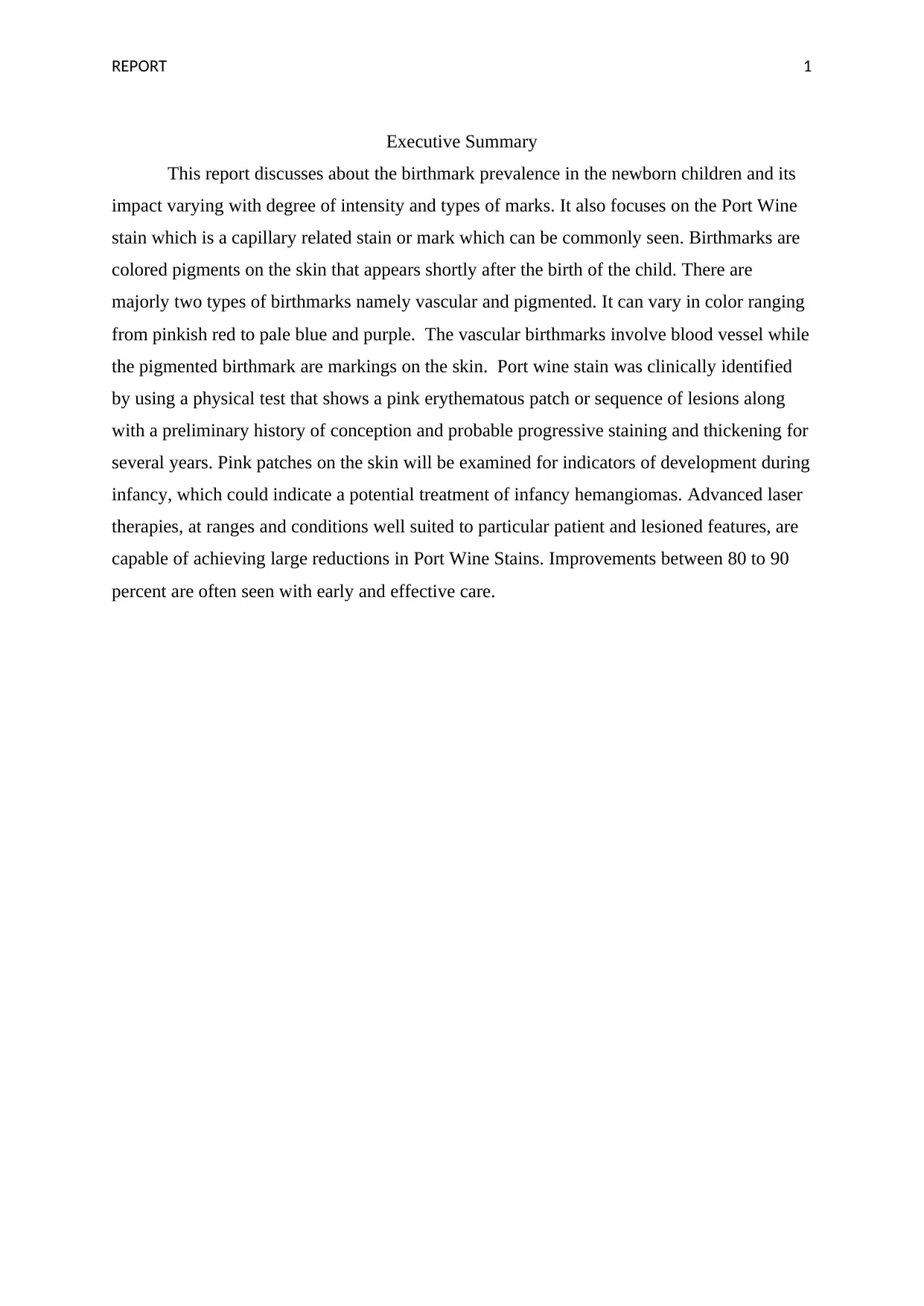
REPORT 1
Executive Summary
This report discusses about the birthmark prevalence in the newborn children and its
impact varying with degree of intensity and types of marks. It also focuses on the Port Wine
stain which is a capillary related stain or mark which can be commonly seen. Birthmarks are
colored pigments on the skin that appears shortly after the birth of the child. There are
majorly two types of birthmarks namely vascular and pigmented. It can vary in color ranging
from pinkish red to pale blue and purple. The vascular birthmarks involve blood vessel while
the pigmented birthmark are markings on the skin. Port wine stain was clinically identified
by using a physical test that shows a pink erythematous patch or sequence of lesions along
with a preliminary history of conception and probable progressive staining and thickening for
several years. Pink patches on the skin will be examined for indicators of development during
infancy, which could indicate a potential treatment of infancy hemangiomas. Advanced laser
therapies, at ranges and conditions well suited to particular patient and lesioned features, are
capable of achieving large reductions in Port Wine Stains. Improvements between 80 to 90
percent are often seen with early and effective care.
Executive Summary
This report discusses about the birthmark prevalence in the newborn children and its
impact varying with degree of intensity and types of marks. It also focuses on the Port Wine
stain which is a capillary related stain or mark which can be commonly seen. Birthmarks are
colored pigments on the skin that appears shortly after the birth of the child. There are
majorly two types of birthmarks namely vascular and pigmented. It can vary in color ranging
from pinkish red to pale blue and purple. The vascular birthmarks involve blood vessel while
the pigmented birthmark are markings on the skin. Port wine stain was clinically identified
by using a physical test that shows a pink erythematous patch or sequence of lesions along
with a preliminary history of conception and probable progressive staining and thickening for
several years. Pink patches on the skin will be examined for indicators of development during
infancy, which could indicate a potential treatment of infancy hemangiomas. Advanced laser
therapies, at ranges and conditions well suited to particular patient and lesioned features, are
capable of achieving large reductions in Port Wine Stains. Improvements between 80 to 90
percent are often seen with early and effective care.

REPORT 2
Contents
Executive Summary...................................................................................................................1
Introduction................................................................................................................................3
Birthmarks..................................................................................................................................3
Port Wine stain...........................................................................................................................5
Conclusion..................................................................................................................................9
References................................................................................................................................10
Contents
Executive Summary...................................................................................................................1
Introduction................................................................................................................................3
Birthmarks..................................................................................................................................3
Port Wine stain...........................................................................................................................5
Conclusion..................................................................................................................................9
References................................................................................................................................10
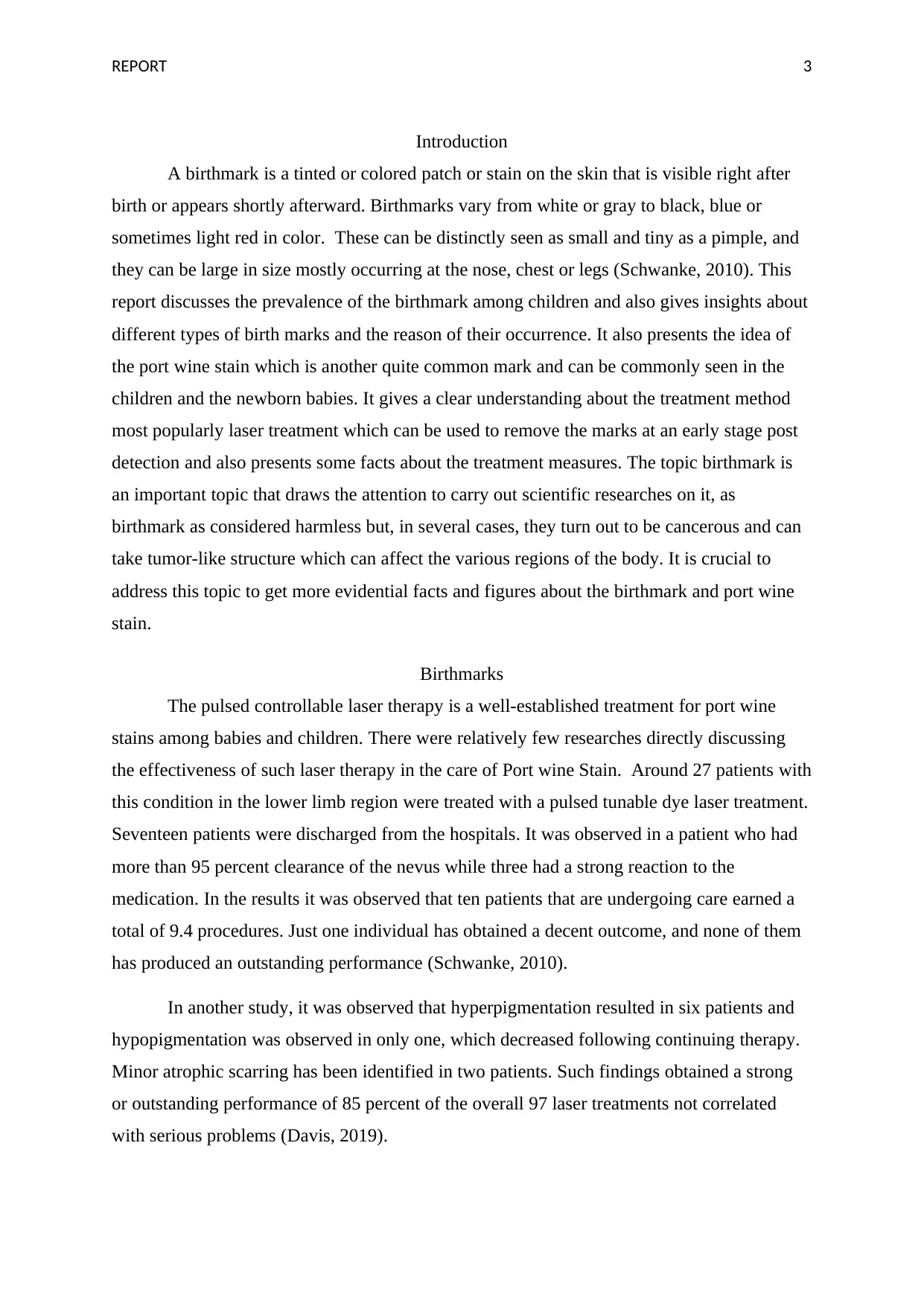
REPORT 3
Introduction
A birthmark is a tinted or colored patch or stain on the skin that is visible right after
birth or appears shortly afterward. Birthmarks vary from white or gray to black, blue or
sometimes light red in color. These can be distinctly seen as small and tiny as a pimple, and
they can be large in size mostly occurring at the nose, chest or legs (Schwanke, 2010). This
report discusses the prevalence of the birthmark among children and also gives insights about
different types of birth marks and the reason of their occurrence. It also presents the idea of
the port wine stain which is another quite common mark and can be commonly seen in the
children and the newborn babies. It gives a clear understanding about the treatment method
most popularly laser treatment which can be used to remove the marks at an early stage post
detection and also presents some facts about the treatment measures. The topic birthmark is
an important topic that draws the attention to carry out scientific researches on it, as
birthmark as considered harmless but, in several cases, they turn out to be cancerous and can
take tumor-like structure which can affect the various regions of the body. It is crucial to
address this topic to get more evidential facts and figures about the birthmark and port wine
stain.
Birthmarks
The pulsed controllable laser therapy is a well-established treatment for port wine
stains among babies and children. There were relatively few researches directly discussing
the effectiveness of such laser therapy in the care of Port wine Stain. Around 27 patients with
this condition in the lower limb region were treated with a pulsed tunable dye laser treatment.
Seventeen patients were discharged from the hospitals. It was observed in a patient who had
more than 95 percent clearance of the nevus while three had a strong reaction to the
medication. In the results it was observed that ten patients that are undergoing care earned a
total of 9.4 procedures. Just one individual has obtained a decent outcome, and none of them
has produced an outstanding performance (Schwanke, 2010).
In another study, it was observed that hyperpigmentation resulted in six patients and
hypopigmentation was observed in only one, which decreased following continuing therapy.
Minor atrophic scarring has been identified in two patients. Such findings obtained a strong
or outstanding performance of 85 percent of the overall 97 laser treatments not correlated
with serious problems (Davis, 2019).
Introduction
A birthmark is a tinted or colored patch or stain on the skin that is visible right after
birth or appears shortly afterward. Birthmarks vary from white or gray to black, blue or
sometimes light red in color. These can be distinctly seen as small and tiny as a pimple, and
they can be large in size mostly occurring at the nose, chest or legs (Schwanke, 2010). This
report discusses the prevalence of the birthmark among children and also gives insights about
different types of birth marks and the reason of their occurrence. It also presents the idea of
the port wine stain which is another quite common mark and can be commonly seen in the
children and the newborn babies. It gives a clear understanding about the treatment method
most popularly laser treatment which can be used to remove the marks at an early stage post
detection and also presents some facts about the treatment measures. The topic birthmark is
an important topic that draws the attention to carry out scientific researches on it, as
birthmark as considered harmless but, in several cases, they turn out to be cancerous and can
take tumor-like structure which can affect the various regions of the body. It is crucial to
address this topic to get more evidential facts and figures about the birthmark and port wine
stain.
Birthmarks
The pulsed controllable laser therapy is a well-established treatment for port wine
stains among babies and children. There were relatively few researches directly discussing
the effectiveness of such laser therapy in the care of Port wine Stain. Around 27 patients with
this condition in the lower limb region were treated with a pulsed tunable dye laser treatment.
Seventeen patients were discharged from the hospitals. It was observed in a patient who had
more than 95 percent clearance of the nevus while three had a strong reaction to the
medication. In the results it was observed that ten patients that are undergoing care earned a
total of 9.4 procedures. Just one individual has obtained a decent outcome, and none of them
has produced an outstanding performance (Schwanke, 2010).
In another study, it was observed that hyperpigmentation resulted in six patients and
hypopigmentation was observed in only one, which decreased following continuing therapy.
Minor atrophic scarring has been identified in two patients. Such findings obtained a strong
or outstanding performance of 85 percent of the overall 97 laser treatments not correlated
with serious problems (Davis, 2019).
Secure Best Marks with AI Grader
Need help grading? Try our AI Grader for instant feedback on your assignments.
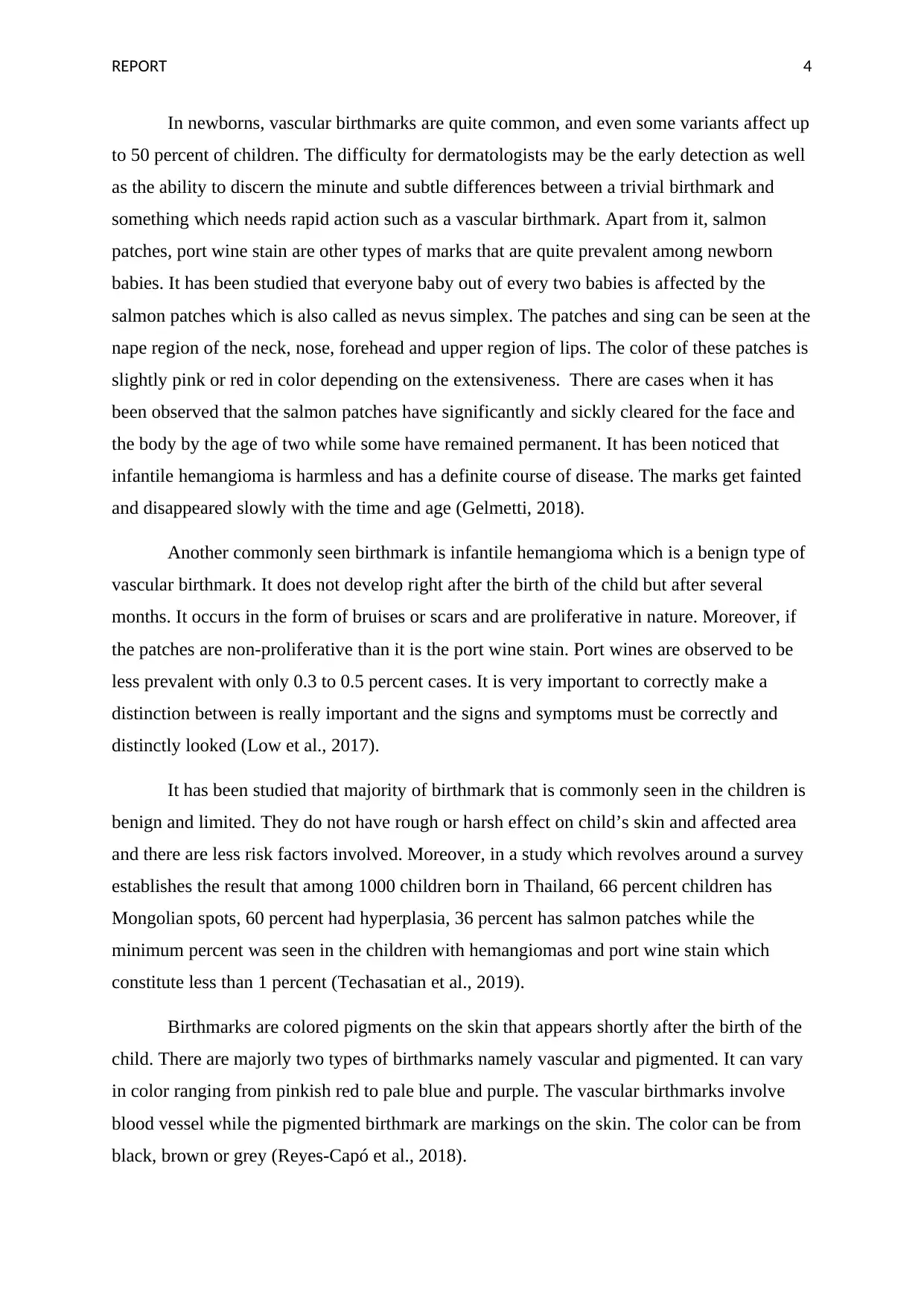
REPORT 4
In newborns, vascular birthmarks are quite common, and even some variants affect up
to 50 percent of children. The difficulty for dermatologists may be the early detection as well
as the ability to discern the minute and subtle differences between a trivial birthmark and
something which needs rapid action such as a vascular birthmark. Apart from it, salmon
patches, port wine stain are other types of marks that are quite prevalent among newborn
babies. It has been studied that everyone baby out of every two babies is affected by the
salmon patches which is also called as nevus simplex. The patches and sing can be seen at the
nape region of the neck, nose, forehead and upper region of lips. The color of these patches is
slightly pink or red in color depending on the extensiveness. There are cases when it has
been observed that the salmon patches have significantly and sickly cleared for the face and
the body by the age of two while some have remained permanent. It has been noticed that
infantile hemangioma is harmless and has a definite course of disease. The marks get fainted
and disappeared slowly with the time and age (Gelmetti, 2018).
Another commonly seen birthmark is infantile hemangioma which is a benign type of
vascular birthmark. It does not develop right after the birth of the child but after several
months. It occurs in the form of bruises or scars and are proliferative in nature. Moreover, if
the patches are non-proliferative than it is the port wine stain. Port wines are observed to be
less prevalent with only 0.3 to 0.5 percent cases. It is very important to correctly make a
distinction between is really important and the signs and symptoms must be correctly and
distinctly looked (Low et al., 2017).
It has been studied that majority of birthmark that is commonly seen in the children is
benign and limited. They do not have rough or harsh effect on child’s skin and affected area
and there are less risk factors involved. Moreover, in a study which revolves around a survey
establishes the result that among 1000 children born in Thailand, 66 percent children has
Mongolian spots, 60 percent had hyperplasia, 36 percent has salmon patches while the
minimum percent was seen in the children with hemangiomas and port wine stain which
constitute less than 1 percent (Techasatian et al., 2019).
Birthmarks are colored pigments on the skin that appears shortly after the birth of the
child. There are majorly two types of birthmarks namely vascular and pigmented. It can vary
in color ranging from pinkish red to pale blue and purple. The vascular birthmarks involve
blood vessel while the pigmented birthmark are markings on the skin. The color can be from
black, brown or grey (Reyes-Capó et al., 2018).
In newborns, vascular birthmarks are quite common, and even some variants affect up
to 50 percent of children. The difficulty for dermatologists may be the early detection as well
as the ability to discern the minute and subtle differences between a trivial birthmark and
something which needs rapid action such as a vascular birthmark. Apart from it, salmon
patches, port wine stain are other types of marks that are quite prevalent among newborn
babies. It has been studied that everyone baby out of every two babies is affected by the
salmon patches which is also called as nevus simplex. The patches and sing can be seen at the
nape region of the neck, nose, forehead and upper region of lips. The color of these patches is
slightly pink or red in color depending on the extensiveness. There are cases when it has
been observed that the salmon patches have significantly and sickly cleared for the face and
the body by the age of two while some have remained permanent. It has been noticed that
infantile hemangioma is harmless and has a definite course of disease. The marks get fainted
and disappeared slowly with the time and age (Gelmetti, 2018).
Another commonly seen birthmark is infantile hemangioma which is a benign type of
vascular birthmark. It does not develop right after the birth of the child but after several
months. It occurs in the form of bruises or scars and are proliferative in nature. Moreover, if
the patches are non-proliferative than it is the port wine stain. Port wines are observed to be
less prevalent with only 0.3 to 0.5 percent cases. It is very important to correctly make a
distinction between is really important and the signs and symptoms must be correctly and
distinctly looked (Low et al., 2017).
It has been studied that majority of birthmark that is commonly seen in the children is
benign and limited. They do not have rough or harsh effect on child’s skin and affected area
and there are less risk factors involved. Moreover, in a study which revolves around a survey
establishes the result that among 1000 children born in Thailand, 66 percent children has
Mongolian spots, 60 percent had hyperplasia, 36 percent has salmon patches while the
minimum percent was seen in the children with hemangiomas and port wine stain which
constitute less than 1 percent (Techasatian et al., 2019).
Birthmarks are colored pigments on the skin that appears shortly after the birth of the
child. There are majorly two types of birthmarks namely vascular and pigmented. It can vary
in color ranging from pinkish red to pale blue and purple. The vascular birthmarks involve
blood vessel while the pigmented birthmark are markings on the skin. The color can be from
black, brown or grey (Reyes-Capó et al., 2018).
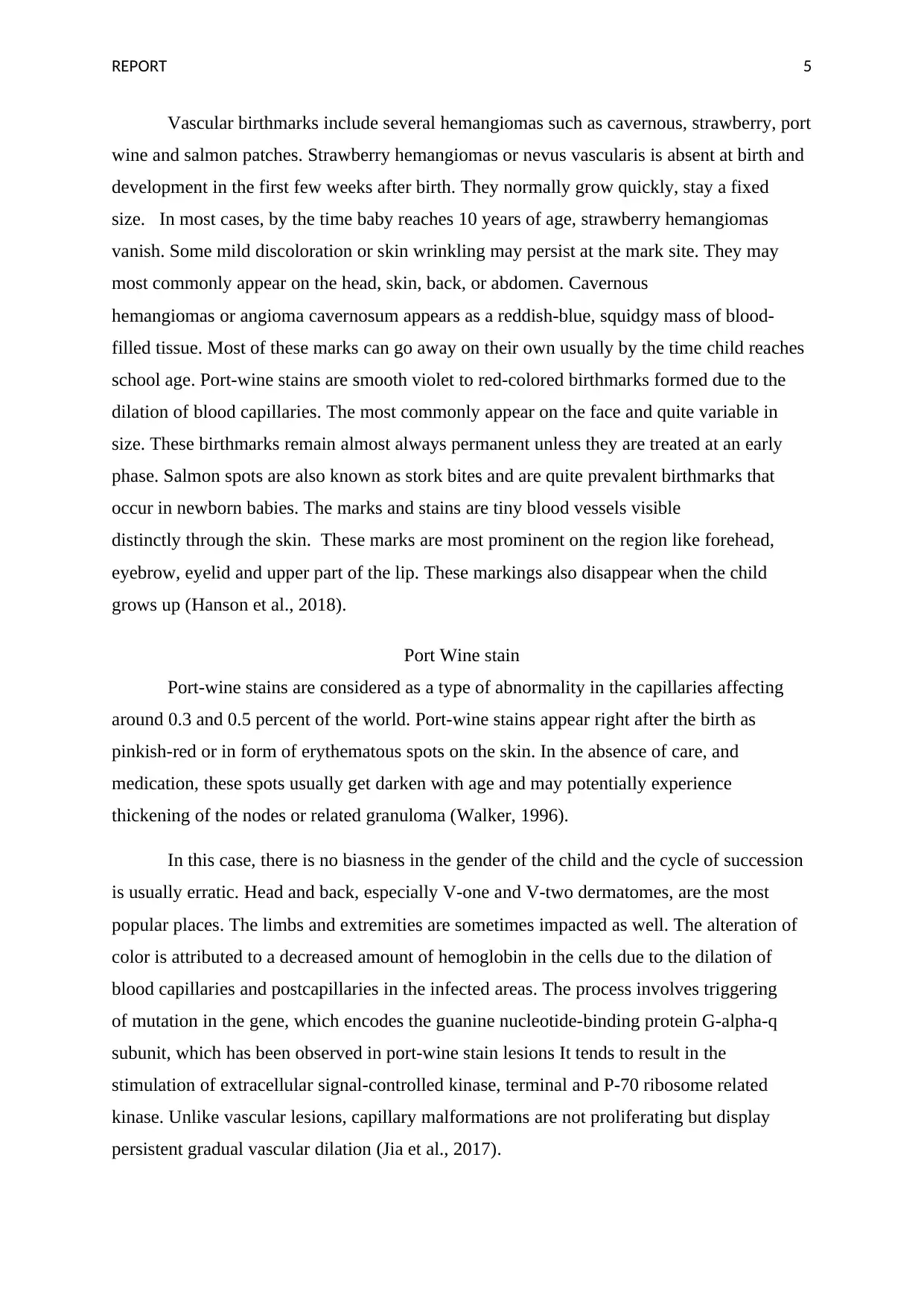
REPORT 5
Vascular birthmarks include several hemangiomas such as cavernous, strawberry, port
wine and salmon patches. Strawberry hemangiomas or nevus vascularis is absent at birth and
development in the first few weeks after birth. They normally grow quickly, stay a fixed
size. In most cases, by the time baby reaches 10 years of age, strawberry hemangiomas
vanish. Some mild discoloration or skin wrinkling may persist at the mark site. They may
most commonly appear on the head, skin, back, or abdomen. Cavernous
hemangiomas or angioma cavernosum appears as a reddish-blue, squidgy mass of blood-
filled tissue. Most of these marks can go away on their own usually by the time child reaches
school age. Port-wine stains are smooth violet to red-colored birthmarks formed due to the
dilation of blood capillaries. The most commonly appear on the face and quite variable in
size. These birthmarks remain almost always permanent unless they are treated at an early
phase. Salmon spots are also known as stork bites and are quite prevalent birthmarks that
occur in newborn babies. The marks and stains are tiny blood vessels visible
distinctly through the skin. These marks are most prominent on the region like forehead,
eyebrow, eyelid and upper part of the lip. These markings also disappear when the child
grows up (Hanson et al., 2018).
Port Wine stain
Port-wine stains are considered as a type of abnormality in the capillaries affecting
around 0.3 and 0.5 percent of the world. Port-wine stains appear right after the birth as
pinkish-red or in form of erythematous spots on the skin. In the absence of care, and
medication, these spots usually get darken with age and may potentially experience
thickening of the nodes or related granuloma (Walker, 1996).
In this case, there is no biasness in the gender of the child and the cycle of succession
is usually erratic. Head and back, especially V-one and V-two dermatomes, are the most
popular places. The limbs and extremities are sometimes impacted as well. The alteration of
color is attributed to a decreased amount of hemoglobin in the cells due to the dilation of
blood capillaries and postcapillaries in the infected areas. The process involves triggering
of mutation in the gene, which encodes the guanine nucleotide-binding protein G-alpha-q
subunit, which has been observed in port-wine stain lesions It tends to result in the
stimulation of extracellular signal-controlled kinase, terminal and P-70 ribosome related
kinase. Unlike vascular lesions, capillary malformations are not proliferating but display
persistent gradual vascular dilation (Jia et al., 2017).
Vascular birthmarks include several hemangiomas such as cavernous, strawberry, port
wine and salmon patches. Strawberry hemangiomas or nevus vascularis is absent at birth and
development in the first few weeks after birth. They normally grow quickly, stay a fixed
size. In most cases, by the time baby reaches 10 years of age, strawberry hemangiomas
vanish. Some mild discoloration or skin wrinkling may persist at the mark site. They may
most commonly appear on the head, skin, back, or abdomen. Cavernous
hemangiomas or angioma cavernosum appears as a reddish-blue, squidgy mass of blood-
filled tissue. Most of these marks can go away on their own usually by the time child reaches
school age. Port-wine stains are smooth violet to red-colored birthmarks formed due to the
dilation of blood capillaries. The most commonly appear on the face and quite variable in
size. These birthmarks remain almost always permanent unless they are treated at an early
phase. Salmon spots are also known as stork bites and are quite prevalent birthmarks that
occur in newborn babies. The marks and stains are tiny blood vessels visible
distinctly through the skin. These marks are most prominent on the region like forehead,
eyebrow, eyelid and upper part of the lip. These markings also disappear when the child
grows up (Hanson et al., 2018).
Port Wine stain
Port-wine stains are considered as a type of abnormality in the capillaries affecting
around 0.3 and 0.5 percent of the world. Port-wine stains appear right after the birth as
pinkish-red or in form of erythematous spots on the skin. In the absence of care, and
medication, these spots usually get darken with age and may potentially experience
thickening of the nodes or related granuloma (Walker, 1996).
In this case, there is no biasness in the gender of the child and the cycle of succession
is usually erratic. Head and back, especially V-one and V-two dermatomes, are the most
popular places. The limbs and extremities are sometimes impacted as well. The alteration of
color is attributed to a decreased amount of hemoglobin in the cells due to the dilation of
blood capillaries and postcapillaries in the infected areas. The process involves triggering
of mutation in the gene, which encodes the guanine nucleotide-binding protein G-alpha-q
subunit, which has been observed in port-wine stain lesions It tends to result in the
stimulation of extracellular signal-controlled kinase, terminal and P-70 ribosome related
kinase. Unlike vascular lesions, capillary malformations are not proliferating but display
persistent gradual vascular dilation (Jia et al., 2017).
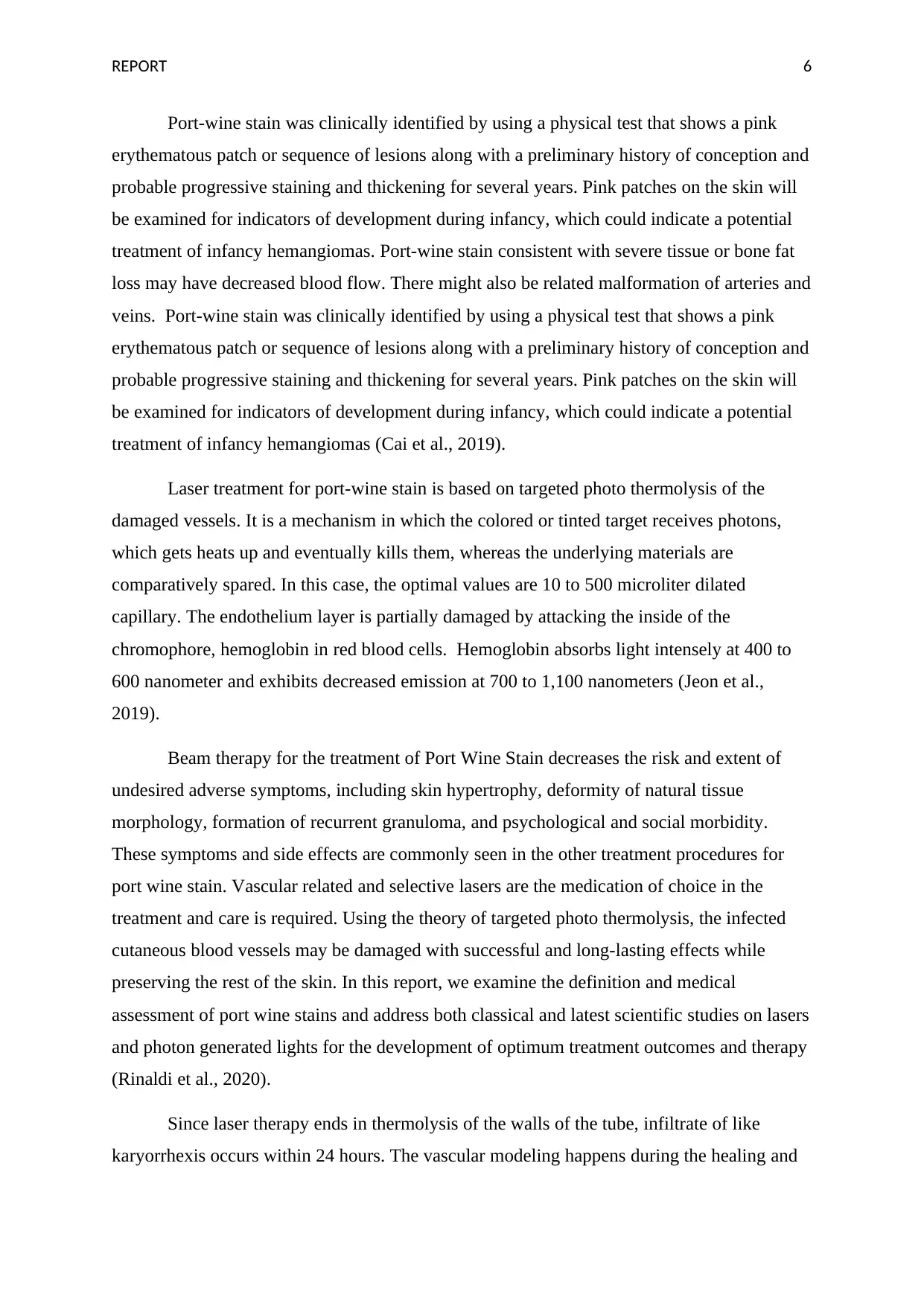
REPORT 6
Port-wine stain was clinically identified by using a physical test that shows a pink
erythematous patch or sequence of lesions along with a preliminary history of conception and
probable progressive staining and thickening for several years. Pink patches on the skin will
be examined for indicators of development during infancy, which could indicate a potential
treatment of infancy hemangiomas. Port-wine stain consistent with severe tissue or bone fat
loss may have decreased blood flow. There might also be related malformation of arteries and
veins. Port-wine stain was clinically identified by using a physical test that shows a pink
erythematous patch or sequence of lesions along with a preliminary history of conception and
probable progressive staining and thickening for several years. Pink patches on the skin will
be examined for indicators of development during infancy, which could indicate a potential
treatment of infancy hemangiomas (Cai et al., 2019).
Laser treatment for port-wine stain is based on targeted photo thermolysis of the
damaged vessels. It is a mechanism in which the colored or tinted target receives photons,
which gets heats up and eventually kills them, whereas the underlying materials are
comparatively spared. In this case, the optimal values are 10 to 500 microliter dilated
capillary. The endothelium layer is partially damaged by attacking the inside of the
chromophore, hemoglobin in red blood cells. Hemoglobin absorbs light intensely at 400 to
600 nanometer and exhibits decreased emission at 700 to 1,100 nanometers (Jeon et al.,
2019).
Beam therapy for the treatment of Port Wine Stain decreases the risk and extent of
undesired adverse symptoms, including skin hypertrophy, deformity of natural tissue
morphology, formation of recurrent granuloma, and psychological and social morbidity.
These symptoms and side effects are commonly seen in the other treatment procedures for
port wine stain. Vascular related and selective lasers are the medication of choice in the
treatment and care is required. Using the theory of targeted photo thermolysis, the infected
cutaneous blood vessels may be damaged with successful and long-lasting effects while
preserving the rest of the skin. In this report, we examine the definition and medical
assessment of port wine stains and address both classical and latest scientific studies on lasers
and photon generated lights for the development of optimum treatment outcomes and therapy
(Rinaldi et al., 2020).
Since laser therapy ends in thermolysis of the walls of the tube, infiltrate of like
karyorrhexis occurs within 24 hours. The vascular modeling happens during the healing and
Port-wine stain was clinically identified by using a physical test that shows a pink
erythematous patch or sequence of lesions along with a preliminary history of conception and
probable progressive staining and thickening for several years. Pink patches on the skin will
be examined for indicators of development during infancy, which could indicate a potential
treatment of infancy hemangiomas. Port-wine stain consistent with severe tissue or bone fat
loss may have decreased blood flow. There might also be related malformation of arteries and
veins. Port-wine stain was clinically identified by using a physical test that shows a pink
erythematous patch or sequence of lesions along with a preliminary history of conception and
probable progressive staining and thickening for several years. Pink patches on the skin will
be examined for indicators of development during infancy, which could indicate a potential
treatment of infancy hemangiomas (Cai et al., 2019).
Laser treatment for port-wine stain is based on targeted photo thermolysis of the
damaged vessels. It is a mechanism in which the colored or tinted target receives photons,
which gets heats up and eventually kills them, whereas the underlying materials are
comparatively spared. In this case, the optimal values are 10 to 500 microliter dilated
capillary. The endothelium layer is partially damaged by attacking the inside of the
chromophore, hemoglobin in red blood cells. Hemoglobin absorbs light intensely at 400 to
600 nanometer and exhibits decreased emission at 700 to 1,100 nanometers (Jeon et al.,
2019).
Beam therapy for the treatment of Port Wine Stain decreases the risk and extent of
undesired adverse symptoms, including skin hypertrophy, deformity of natural tissue
morphology, formation of recurrent granuloma, and psychological and social morbidity.
These symptoms and side effects are commonly seen in the other treatment procedures for
port wine stain. Vascular related and selective lasers are the medication of choice in the
treatment and care is required. Using the theory of targeted photo thermolysis, the infected
cutaneous blood vessels may be damaged with successful and long-lasting effects while
preserving the rest of the skin. In this report, we examine the definition and medical
assessment of port wine stains and address both classical and latest scientific studies on lasers
and photon generated lights for the development of optimum treatment outcomes and therapy
(Rinaldi et al., 2020).
Since laser therapy ends in thermolysis of the walls of the tube, infiltrate of like
karyorrhexis occurs within 24 hours. The vascular modeling happens during the healing and
Paraphrase This Document
Need a fresh take? Get an instant paraphrase of this document with our AI Paraphraser
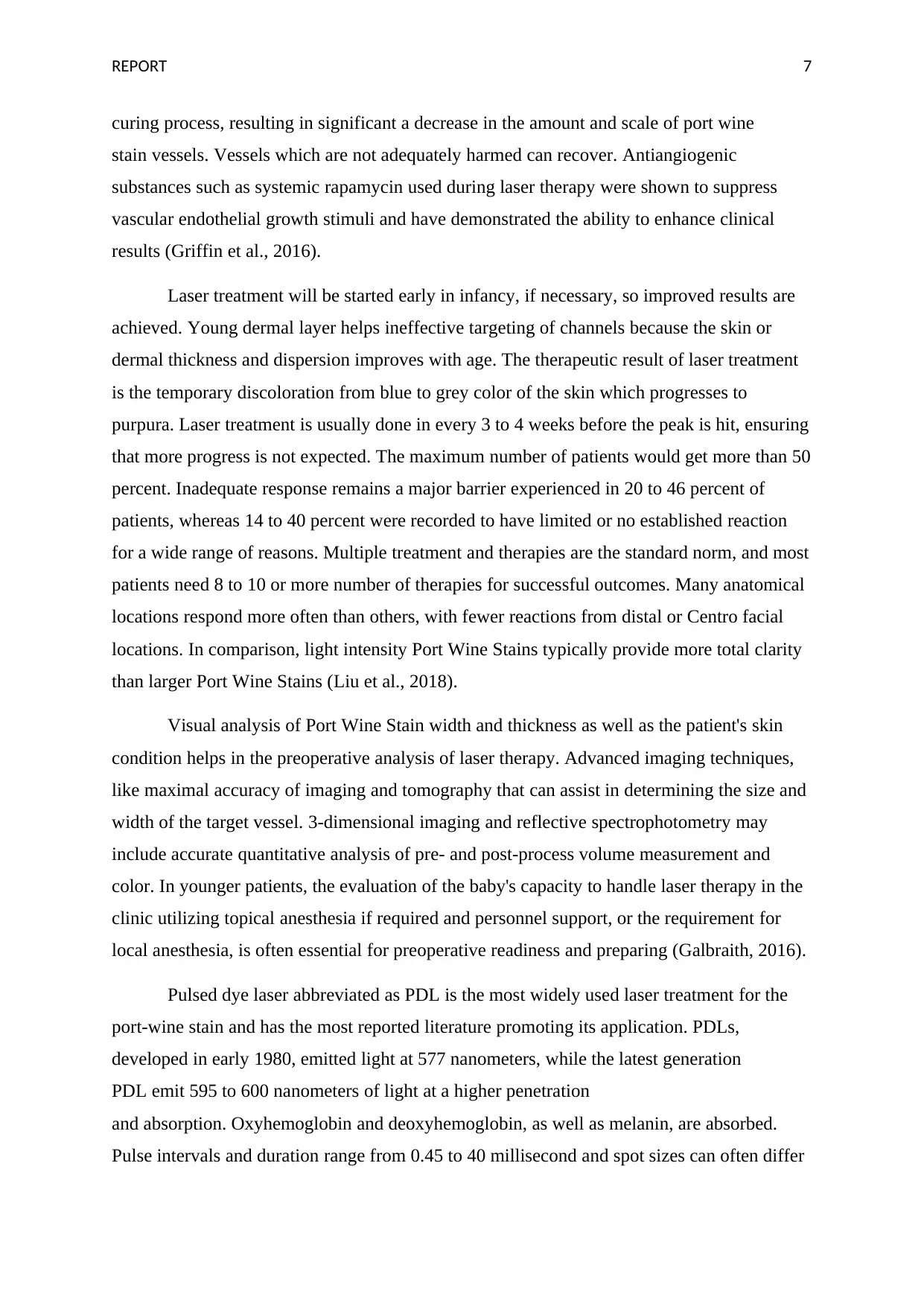
REPORT 7
curing process, resulting in significant a decrease in the amount and scale of port wine
stain vessels. Vessels which are not adequately harmed can recover. Antiangiogenic
substances such as systemic rapamycin used during laser therapy were shown to suppress
vascular endothelial growth stimuli and have demonstrated the ability to enhance clinical
results (Griffin et al., 2016).
Laser treatment will be started early in infancy, if necessary, so improved results are
achieved. Young dermal layer helps ineffective targeting of channels because the skin or
dermal thickness and dispersion improves with age. The therapeutic result of laser treatment
is the temporary discoloration from blue to grey color of the skin which progresses to
purpura. Laser treatment is usually done in every 3 to 4 weeks before the peak is hit, ensuring
that more progress is not expected. The maximum number of patients would get more than 50
percent. Inadequate response remains a major barrier experienced in 20 to 46 percent of
patients, whereas 14 to 40 percent were recorded to have limited or no established reaction
for a wide range of reasons. Multiple treatment and therapies are the standard norm, and most
patients need 8 to 10 or more number of therapies for successful outcomes. Many anatomical
locations respond more often than others, with fewer reactions from distal or Centro facial
locations. In comparison, light intensity Port Wine Stains typically provide more total clarity
than larger Port Wine Stains (Liu et al., 2018).
Visual analysis of Port Wine Stain width and thickness as well as the patient's skin
condition helps in the preoperative analysis of laser therapy. Advanced imaging techniques,
like maximal accuracy of imaging and tomography that can assist in determining the size and
width of the target vessel. 3-dimensional imaging and reflective spectrophotometry may
include accurate quantitative analysis of pre- and post-process volume measurement and
color. In younger patients, the evaluation of the baby's capacity to handle laser therapy in the
clinic utilizing topical anesthesia if required and personnel support, or the requirement for
local anesthesia, is often essential for preoperative readiness and preparing (Galbraith, 2016).
Pulsed dye laser abbreviated as PDL is the most widely used laser treatment for the
port-wine stain and has the most reported literature promoting its application. PDLs,
developed in early 1980, emitted light at 577 nanometers, while the latest generation
PDL emit 595 to 600 nanometers of light at a higher penetration
and absorption. Oxyhemoglobin and deoxyhemoglobin, as well as melanin, are absorbed.
Pulse intervals and duration range from 0.45 to 40 millisecond and spot sizes can often differ
curing process, resulting in significant a decrease in the amount and scale of port wine
stain vessels. Vessels which are not adequately harmed can recover. Antiangiogenic
substances such as systemic rapamycin used during laser therapy were shown to suppress
vascular endothelial growth stimuli and have demonstrated the ability to enhance clinical
results (Griffin et al., 2016).
Laser treatment will be started early in infancy, if necessary, so improved results are
achieved. Young dermal layer helps ineffective targeting of channels because the skin or
dermal thickness and dispersion improves with age. The therapeutic result of laser treatment
is the temporary discoloration from blue to grey color of the skin which progresses to
purpura. Laser treatment is usually done in every 3 to 4 weeks before the peak is hit, ensuring
that more progress is not expected. The maximum number of patients would get more than 50
percent. Inadequate response remains a major barrier experienced in 20 to 46 percent of
patients, whereas 14 to 40 percent were recorded to have limited or no established reaction
for a wide range of reasons. Multiple treatment and therapies are the standard norm, and most
patients need 8 to 10 or more number of therapies for successful outcomes. Many anatomical
locations respond more often than others, with fewer reactions from distal or Centro facial
locations. In comparison, light intensity Port Wine Stains typically provide more total clarity
than larger Port Wine Stains (Liu et al., 2018).
Visual analysis of Port Wine Stain width and thickness as well as the patient's skin
condition helps in the preoperative analysis of laser therapy. Advanced imaging techniques,
like maximal accuracy of imaging and tomography that can assist in determining the size and
width of the target vessel. 3-dimensional imaging and reflective spectrophotometry may
include accurate quantitative analysis of pre- and post-process volume measurement and
color. In younger patients, the evaluation of the baby's capacity to handle laser therapy in the
clinic utilizing topical anesthesia if required and personnel support, or the requirement for
local anesthesia, is often essential for preoperative readiness and preparing (Galbraith, 2016).
Pulsed dye laser abbreviated as PDL is the most widely used laser treatment for the
port-wine stain and has the most reported literature promoting its application. PDLs,
developed in early 1980, emitted light at 577 nanometers, while the latest generation
PDL emit 595 to 600 nanometers of light at a higher penetration
and absorption. Oxyhemoglobin and deoxyhemoglobin, as well as melanin, are absorbed.
Pulse intervals and duration range from 0.45 to 40 millisecond and spot sizes can often differ
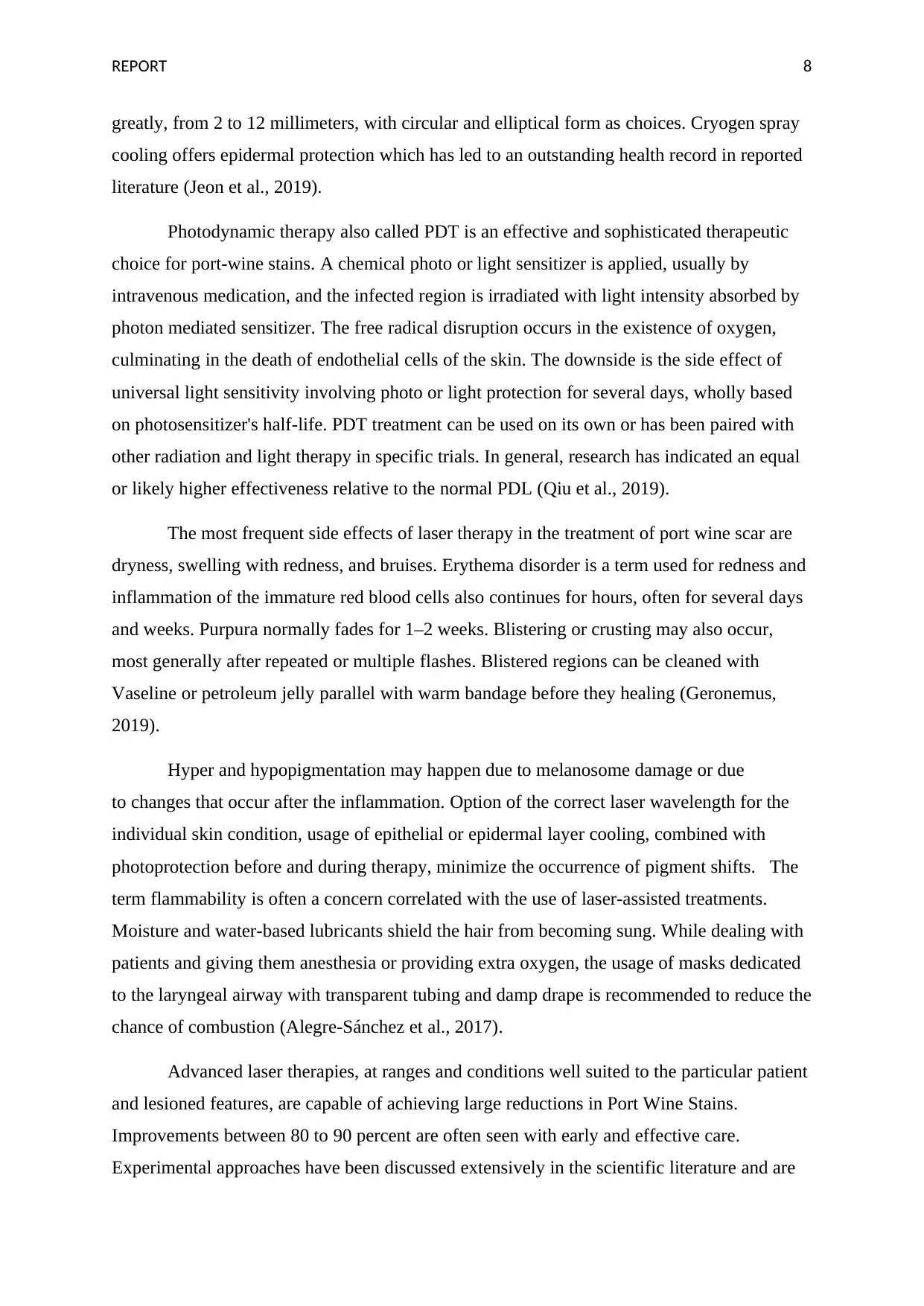
REPORT 8
greatly, from 2 to 12 millimeters, with circular and elliptical form as choices. Cryogen spray
cooling offers epidermal protection which has led to an outstanding health record in reported
literature (Jeon et al., 2019).
Photodynamic therapy also called PDT is an effective and sophisticated therapeutic
choice for port-wine stains. A chemical photo or light sensitizer is applied, usually by
intravenous medication, and the infected region is irradiated with light intensity absorbed by
photon mediated sensitizer. The free radical disruption occurs in the existence of oxygen,
culminating in the death of endothelial cells of the skin. The downside is the side effect of
universal light sensitivity involving photo or light protection for several days, wholly based
on photosensitizer's half-life. PDT treatment can be used on its own or has been paired with
other radiation and light therapy in specific trials. In general, research has indicated an equal
or likely higher effectiveness relative to the normal PDL (Qiu et al., 2019).
The most frequent side effects of laser therapy in the treatment of port wine scar are
dryness, swelling with redness, and bruises. Erythema disorder is a term used for redness and
inflammation of the immature red blood cells also continues for hours, often for several days
and weeks. Purpura normally fades for 1–2 weeks. Blistering or crusting may also occur,
most generally after repeated or multiple flashes. Blistered regions can be cleaned with
Vaseline or petroleum jelly parallel with warm bandage before they healing (Geronemus,
2019).
Hyper and hypopigmentation may happen due to melanosome damage or due
to changes that occur after the inflammation. Option of the correct laser wavelength for the
individual skin condition, usage of epithelial or epidermal layer cooling, combined with
photoprotection before and during therapy, minimize the occurrence of pigment shifts. The
term flammability is often a concern correlated with the use of laser-assisted treatments.
Moisture and water-based lubricants shield the hair from becoming sung. While dealing with
patients and giving them anesthesia or providing extra oxygen, the usage of masks dedicated
to the laryngeal airway with transparent tubing and damp drape is recommended to reduce the
chance of combustion (Alegre‐Sánchez et al., 2017).
Advanced laser therapies, at ranges and conditions well suited to the particular patient
and lesioned features, are capable of achieving large reductions in Port Wine Stains.
Improvements between 80 to 90 percent are often seen with early and effective care.
Experimental approaches have been discussed extensively in the scientific literature and are
greatly, from 2 to 12 millimeters, with circular and elliptical form as choices. Cryogen spray
cooling offers epidermal protection which has led to an outstanding health record in reported
literature (Jeon et al., 2019).
Photodynamic therapy also called PDT is an effective and sophisticated therapeutic
choice for port-wine stains. A chemical photo or light sensitizer is applied, usually by
intravenous medication, and the infected region is irradiated with light intensity absorbed by
photon mediated sensitizer. The free radical disruption occurs in the existence of oxygen,
culminating in the death of endothelial cells of the skin. The downside is the side effect of
universal light sensitivity involving photo or light protection for several days, wholly based
on photosensitizer's half-life. PDT treatment can be used on its own or has been paired with
other radiation and light therapy in specific trials. In general, research has indicated an equal
or likely higher effectiveness relative to the normal PDL (Qiu et al., 2019).
The most frequent side effects of laser therapy in the treatment of port wine scar are
dryness, swelling with redness, and bruises. Erythema disorder is a term used for redness and
inflammation of the immature red blood cells also continues for hours, often for several days
and weeks. Purpura normally fades for 1–2 weeks. Blistering or crusting may also occur,
most generally after repeated or multiple flashes. Blistered regions can be cleaned with
Vaseline or petroleum jelly parallel with warm bandage before they healing (Geronemus,
2019).
Hyper and hypopigmentation may happen due to melanosome damage or due
to changes that occur after the inflammation. Option of the correct laser wavelength for the
individual skin condition, usage of epithelial or epidermal layer cooling, combined with
photoprotection before and during therapy, minimize the occurrence of pigment shifts. The
term flammability is often a concern correlated with the use of laser-assisted treatments.
Moisture and water-based lubricants shield the hair from becoming sung. While dealing with
patients and giving them anesthesia or providing extra oxygen, the usage of masks dedicated
to the laryngeal airway with transparent tubing and damp drape is recommended to reduce the
chance of combustion (Alegre‐Sánchez et al., 2017).
Advanced laser therapies, at ranges and conditions well suited to the particular patient
and lesioned features, are capable of achieving large reductions in Port Wine Stains.
Improvements between 80 to 90 percent are often seen with early and effective care.
Experimental approaches have been discussed extensively in the scientific literature and are
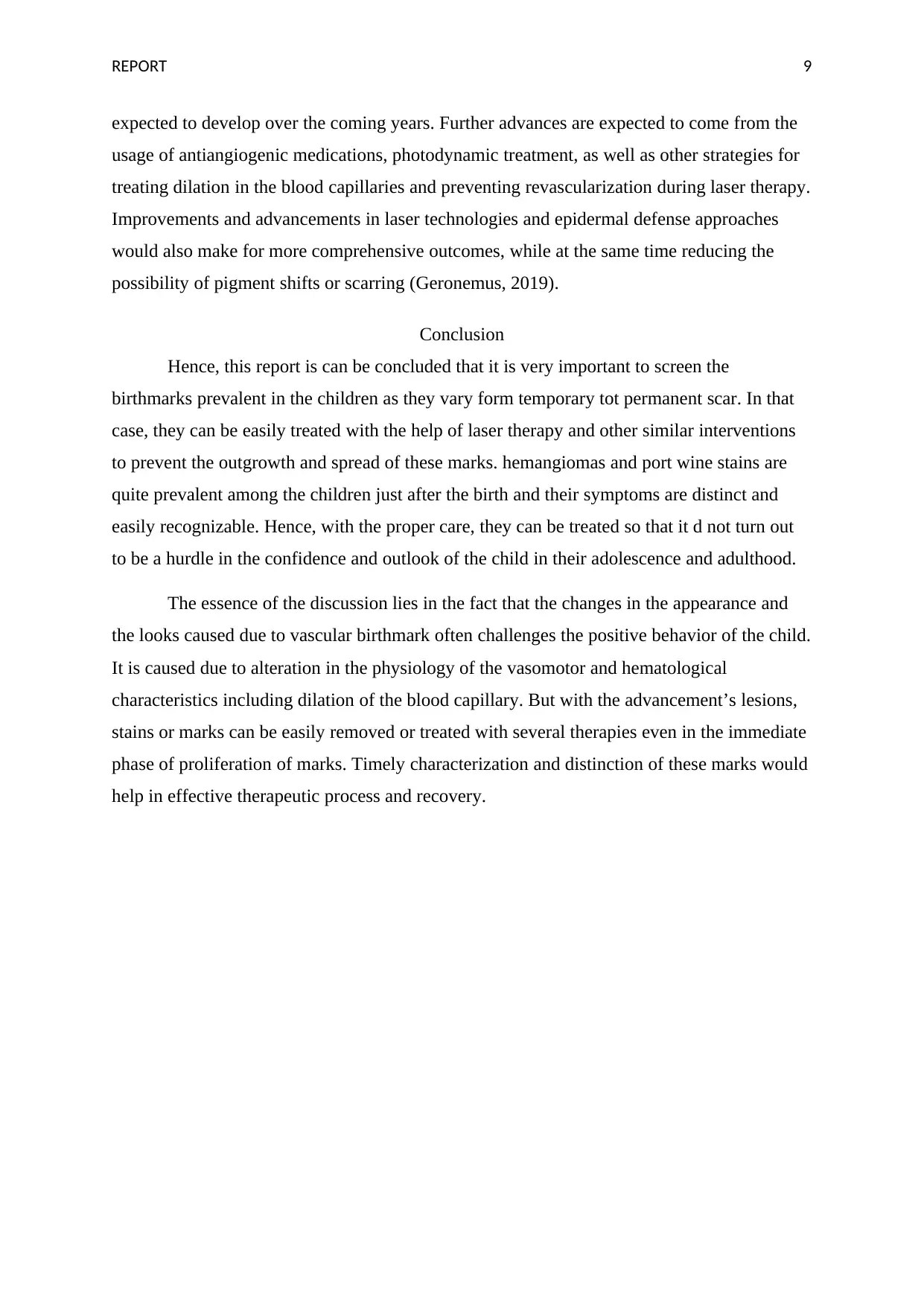
REPORT 9
expected to develop over the coming years. Further advances are expected to come from the
usage of antiangiogenic medications, photodynamic treatment, as well as other strategies for
treating dilation in the blood capillaries and preventing revascularization during laser therapy.
Improvements and advancements in laser technologies and epidermal defense approaches
would also make for more comprehensive outcomes, while at the same time reducing the
possibility of pigment shifts or scarring (Geronemus, 2019).
Conclusion
Hence, this report is can be concluded that it is very important to screen the
birthmarks prevalent in the children as they vary form temporary tot permanent scar. In that
case, they can be easily treated with the help of laser therapy and other similar interventions
to prevent the outgrowth and spread of these marks. hemangiomas and port wine stains are
quite prevalent among the children just after the birth and their symptoms are distinct and
easily recognizable. Hence, with the proper care, they can be treated so that it d not turn out
to be a hurdle in the confidence and outlook of the child in their adolescence and adulthood.
The essence of the discussion lies in the fact that the changes in the appearance and
the looks caused due to vascular birthmark often challenges the positive behavior of the child.
It is caused due to alteration in the physiology of the vasomotor and hematological
characteristics including dilation of the blood capillary. But with the advancement’s lesions,
stains or marks can be easily removed or treated with several therapies even in the immediate
phase of proliferation of marks. Timely characterization and distinction of these marks would
help in effective therapeutic process and recovery.
expected to develop over the coming years. Further advances are expected to come from the
usage of antiangiogenic medications, photodynamic treatment, as well as other strategies for
treating dilation in the blood capillaries and preventing revascularization during laser therapy.
Improvements and advancements in laser technologies and epidermal defense approaches
would also make for more comprehensive outcomes, while at the same time reducing the
possibility of pigment shifts or scarring (Geronemus, 2019).
Conclusion
Hence, this report is can be concluded that it is very important to screen the
birthmarks prevalent in the children as they vary form temporary tot permanent scar. In that
case, they can be easily treated with the help of laser therapy and other similar interventions
to prevent the outgrowth and spread of these marks. hemangiomas and port wine stains are
quite prevalent among the children just after the birth and their symptoms are distinct and
easily recognizable. Hence, with the proper care, they can be treated so that it d not turn out
to be a hurdle in the confidence and outlook of the child in their adolescence and adulthood.
The essence of the discussion lies in the fact that the changes in the appearance and
the looks caused due to vascular birthmark often challenges the positive behavior of the child.
It is caused due to alteration in the physiology of the vasomotor and hematological
characteristics including dilation of the blood capillary. But with the advancement’s lesions,
stains or marks can be easily removed or treated with several therapies even in the immediate
phase of proliferation of marks. Timely characterization and distinction of these marks would
help in effective therapeutic process and recovery.
Secure Best Marks with AI Grader
Need help grading? Try our AI Grader for instant feedback on your assignments.
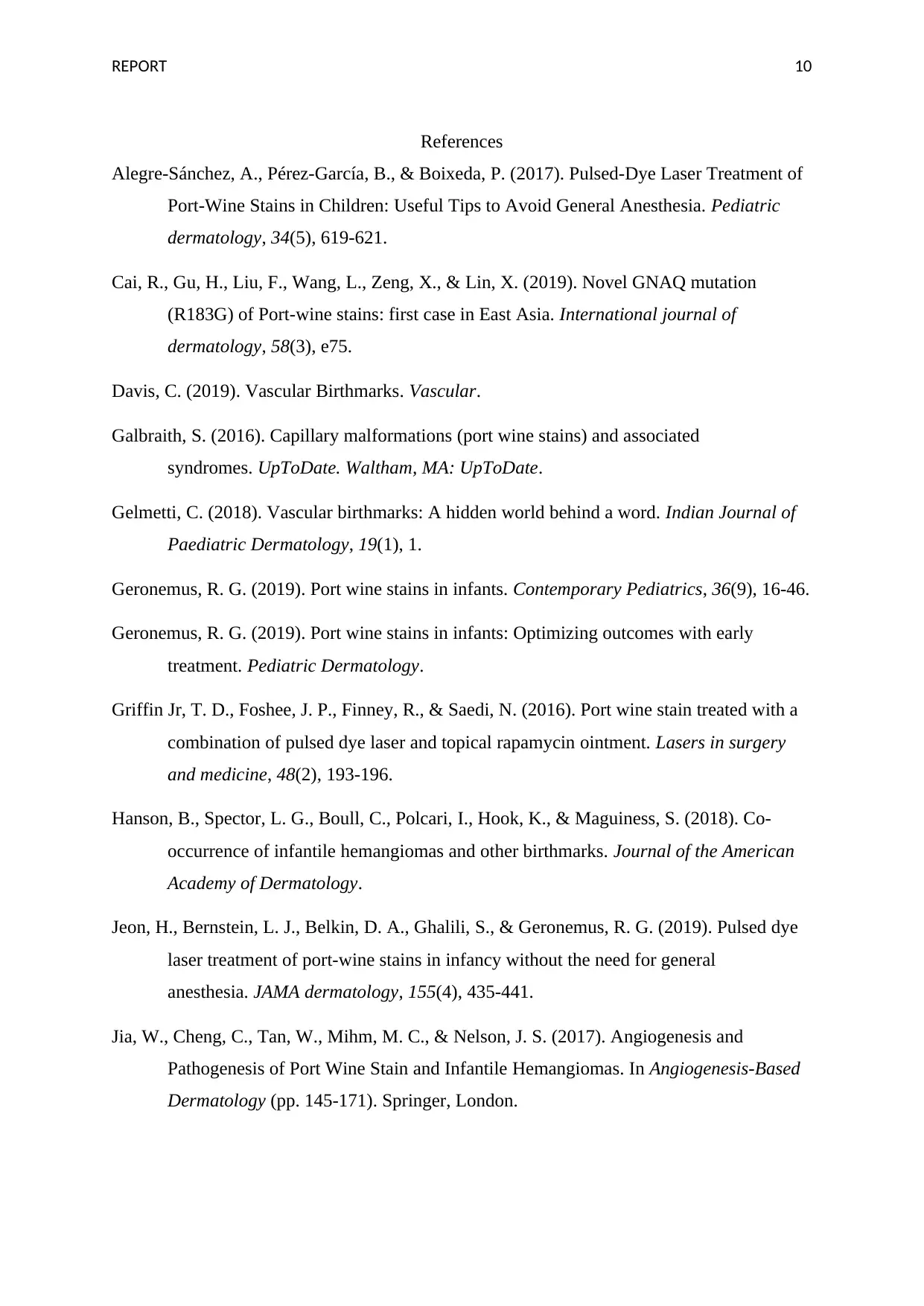
REPORT 10
References
Alegre‐Sánchez, A., Pérez‐García, B., & Boixeda, P. (2017). Pulsed‐Dye Laser Treatment of
Port‐Wine Stains in Children: Useful Tips to Avoid General Anesthesia. Pediatric
dermatology, 34(5), 619-621.
Cai, R., Gu, H., Liu, F., Wang, L., Zeng, X., & Lin, X. (2019). Novel GNAQ mutation
(R183G) of Port-wine stains: first case in East Asia. International journal of
dermatology, 58(3), e75.
Davis, C. (2019). Vascular Birthmarks. Vascular.
Galbraith, S. (2016). Capillary malformations (port wine stains) and associated
syndromes. UpToDate. Waltham, MA: UpToDate.
Gelmetti, C. (2018). Vascular birthmarks: A hidden world behind a word. Indian Journal of
Paediatric Dermatology, 19(1), 1.
Geronemus, R. G. (2019). Port wine stains in infants. Contemporary Pediatrics, 36(9), 16-46.
Geronemus, R. G. (2019). Port wine stains in infants: Optimizing outcomes with early
treatment. Pediatric Dermatology.
Griffin Jr, T. D., Foshee, J. P., Finney, R., & Saedi, N. (2016). Port wine stain treated with a
combination of pulsed dye laser and topical rapamycin ointment. Lasers in surgery
and medicine, 48(2), 193-196.
Hanson, B., Spector, L. G., Boull, C., Polcari, I., Hook, K., & Maguiness, S. (2018). Co-
occurrence of infantile hemangiomas and other birthmarks. Journal of the American
Academy of Dermatology.
Jeon, H., Bernstein, L. J., Belkin, D. A., Ghalili, S., & Geronemus, R. G. (2019). Pulsed dye
laser treatment of port-wine stains in infancy without the need for general
anesthesia. JAMA dermatology, 155(4), 435-441.
Jia, W., Cheng, C., Tan, W., Mihm, M. C., & Nelson, J. S. (2017). Angiogenesis and
Pathogenesis of Port Wine Stain and Infantile Hemangiomas. In Angiogenesis-Based
Dermatology (pp. 145-171). Springer, London.
References
Alegre‐Sánchez, A., Pérez‐García, B., & Boixeda, P. (2017). Pulsed‐Dye Laser Treatment of
Port‐Wine Stains in Children: Useful Tips to Avoid General Anesthesia. Pediatric
dermatology, 34(5), 619-621.
Cai, R., Gu, H., Liu, F., Wang, L., Zeng, X., & Lin, X. (2019). Novel GNAQ mutation
(R183G) of Port-wine stains: first case in East Asia. International journal of
dermatology, 58(3), e75.
Davis, C. (2019). Vascular Birthmarks. Vascular.
Galbraith, S. (2016). Capillary malformations (port wine stains) and associated
syndromes. UpToDate. Waltham, MA: UpToDate.
Gelmetti, C. (2018). Vascular birthmarks: A hidden world behind a word. Indian Journal of
Paediatric Dermatology, 19(1), 1.
Geronemus, R. G. (2019). Port wine stains in infants. Contemporary Pediatrics, 36(9), 16-46.
Geronemus, R. G. (2019). Port wine stains in infants: Optimizing outcomes with early
treatment. Pediatric Dermatology.
Griffin Jr, T. D., Foshee, J. P., Finney, R., & Saedi, N. (2016). Port wine stain treated with a
combination of pulsed dye laser and topical rapamycin ointment. Lasers in surgery
and medicine, 48(2), 193-196.
Hanson, B., Spector, L. G., Boull, C., Polcari, I., Hook, K., & Maguiness, S. (2018). Co-
occurrence of infantile hemangiomas and other birthmarks. Journal of the American
Academy of Dermatology.
Jeon, H., Bernstein, L. J., Belkin, D. A., Ghalili, S., & Geronemus, R. G. (2019). Pulsed dye
laser treatment of port-wine stains in infancy without the need for general
anesthesia. JAMA dermatology, 155(4), 435-441.
Jia, W., Cheng, C., Tan, W., Mihm, M. C., & Nelson, J. S. (2017). Angiogenesis and
Pathogenesis of Port Wine Stain and Infantile Hemangiomas. In Angiogenesis-Based
Dermatology (pp. 145-171). Springer, London.
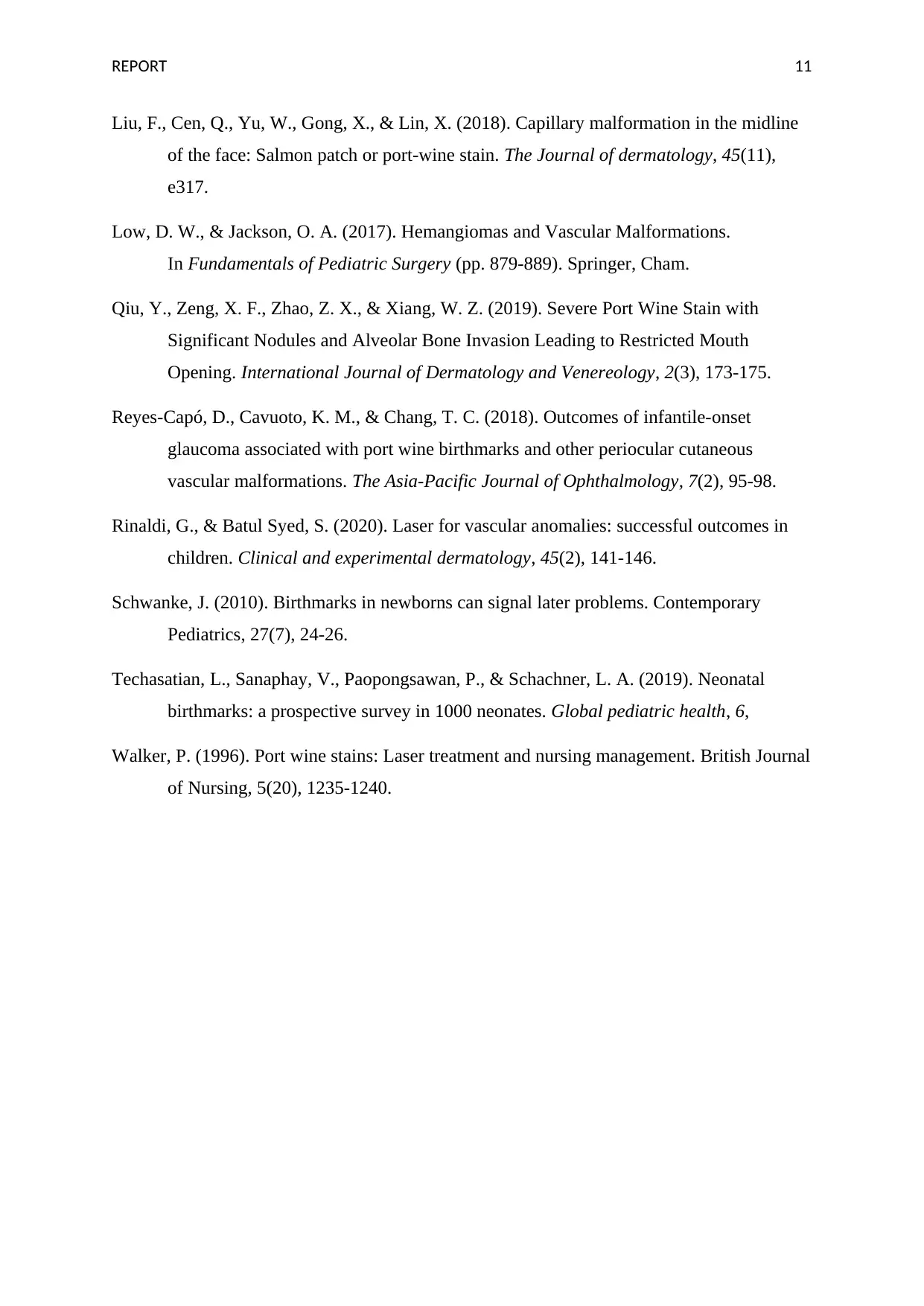
REPORT 11
Liu, F., Cen, Q., Yu, W., Gong, X., & Lin, X. (2018). Capillary malformation in the midline
of the face: Salmon patch or port-wine stain. The Journal of dermatology, 45(11),
e317.
Low, D. W., & Jackson, O. A. (2017). Hemangiomas and Vascular Malformations.
In Fundamentals of Pediatric Surgery (pp. 879-889). Springer, Cham.
Qiu, Y., Zeng, X. F., Zhao, Z. X., & Xiang, W. Z. (2019). Severe Port Wine Stain with
Significant Nodules and Alveolar Bone Invasion Leading to Restricted Mouth
Opening. International Journal of Dermatology and Venereology, 2(3), 173-175.
Reyes-Capó, D., Cavuoto, K. M., & Chang, T. C. (2018). Outcomes of infantile-onset
glaucoma associated with port wine birthmarks and other periocular cutaneous
vascular malformations. The Asia-Pacific Journal of Ophthalmology, 7(2), 95-98.
Rinaldi, G., & Batul Syed, S. (2020). Laser for vascular anomalies: successful outcomes in
children. Clinical and experimental dermatology, 45(2), 141-146.
Schwanke, J. (2010). Birthmarks in newborns can signal later problems. Contemporary
Pediatrics, 27(7), 24-26.
Techasatian, L., Sanaphay, V., Paopongsawan, P., & Schachner, L. A. (2019). Neonatal
birthmarks: a prospective survey in 1000 neonates. Global pediatric health, 6,
Walker, P. (1996). Port wine stains: Laser treatment and nursing management. British Journal
of Nursing, 5(20), 1235-1240.
Liu, F., Cen, Q., Yu, W., Gong, X., & Lin, X. (2018). Capillary malformation in the midline
of the face: Salmon patch or port-wine stain. The Journal of dermatology, 45(11),
e317.
Low, D. W., & Jackson, O. A. (2017). Hemangiomas and Vascular Malformations.
In Fundamentals of Pediatric Surgery (pp. 879-889). Springer, Cham.
Qiu, Y., Zeng, X. F., Zhao, Z. X., & Xiang, W. Z. (2019). Severe Port Wine Stain with
Significant Nodules and Alveolar Bone Invasion Leading to Restricted Mouth
Opening. International Journal of Dermatology and Venereology, 2(3), 173-175.
Reyes-Capó, D., Cavuoto, K. M., & Chang, T. C. (2018). Outcomes of infantile-onset
glaucoma associated with port wine birthmarks and other periocular cutaneous
vascular malformations. The Asia-Pacific Journal of Ophthalmology, 7(2), 95-98.
Rinaldi, G., & Batul Syed, S. (2020). Laser for vascular anomalies: successful outcomes in
children. Clinical and experimental dermatology, 45(2), 141-146.
Schwanke, J. (2010). Birthmarks in newborns can signal later problems. Contemporary
Pediatrics, 27(7), 24-26.
Techasatian, L., Sanaphay, V., Paopongsawan, P., & Schachner, L. A. (2019). Neonatal
birthmarks: a prospective survey in 1000 neonates. Global pediatric health, 6,
Walker, P. (1996). Port wine stains: Laser treatment and nursing management. British Journal
of Nursing, 5(20), 1235-1240.
1 out of 12
Your All-in-One AI-Powered Toolkit for Academic Success.
+13062052269
info@desklib.com
Available 24*7 on WhatsApp / Email
![[object Object]](/_next/static/media/star-bottom.7253800d.svg)
Unlock your academic potential
© 2024 | Zucol Services PVT LTD | All rights reserved.